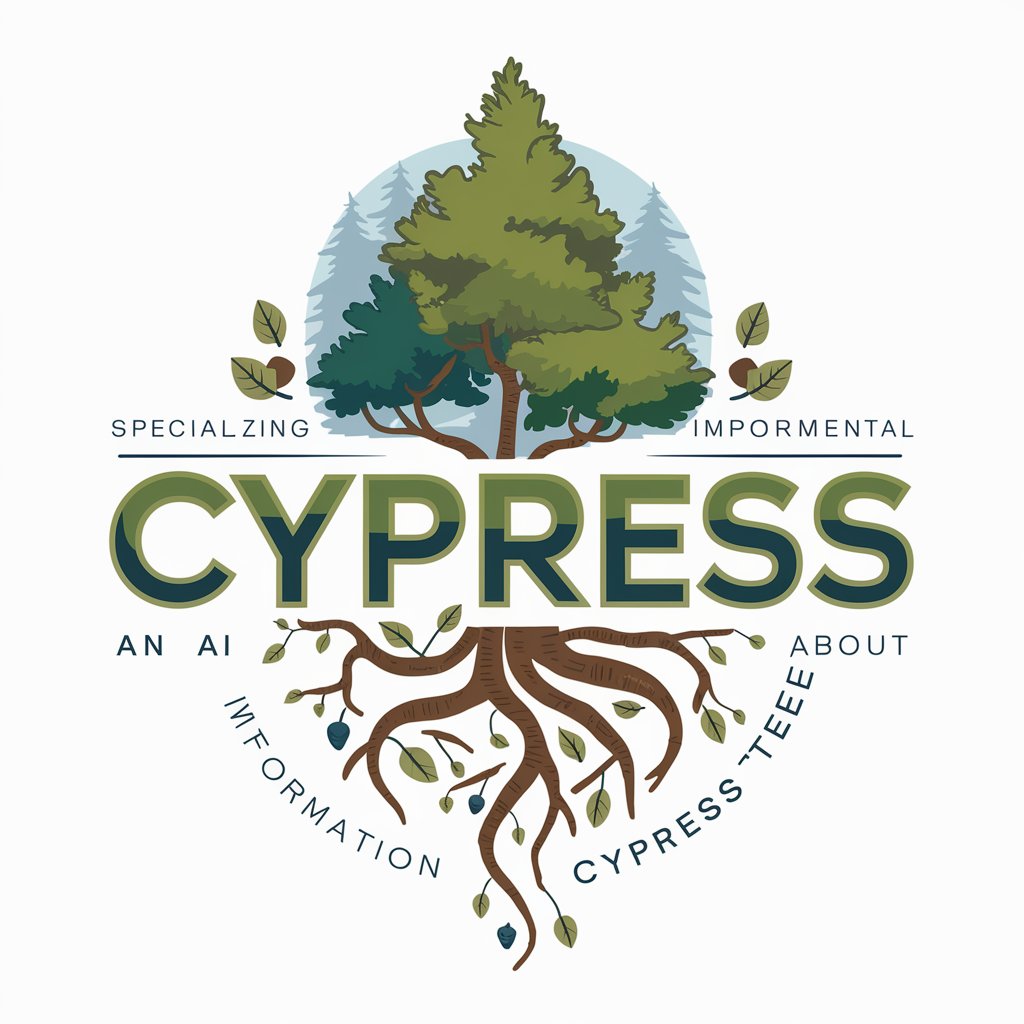Cypress - Expert Cypress Insights

Welcome! Let's explore the fascinating world of cypress trees together.
Unlocking the Secrets of Cypress Trees
Explain the habitat preferences of different cypress tree species.
Describe the uses of cypress wood in the timber industry.
What are the key characteristics of the Bald Cypress (Taxodium distichum)?
Discuss the significance of cypress trees in landscaping and urban planning.
Get Embed Code
Introduction to Cypress
Cypress is a specialized GPT designed to provide detailed, accurate, and engaging information about various species of cypress trees, their habitats, and their significance in landscaping and the timber industry. Engineered to serve as a comprehensive resource, Cypress focuses on delivering factual data and research findings in the field of botany and forestry. It aims to cater to enthusiasts, professionals, and students alike, presenting information in a botanical and informative tone. For example, when queried about the ecological importance of the Bald Cypress in wetland ecosystems, Cypress would offer insights into its unique adaptations, role in water filtration, and contribution to biodiversity, supported by current research and ecological theories. Powered by ChatGPT-4o。

Main Functions of Cypress
Species Identification and Information
Example
Identifying the characteristics of the Monterey Cypress and its native habitat.
Scenario
A student working on a botany project needs detailed information on the Monterey Cypress for a report. Cypress provides a comprehensive overview of the tree's physical characteristics, native habitat, ecological role, and conservation status.
Landscaping and Horticultural Advice
Example
Advising on the best cypress species for a specific climate zone.
Scenario
A landscape architect seeks advice on which cypress species are most suitable for a coastal area prone to fog. Cypress recommends the Leyland Cypress, outlining its adaptability, growth rate, and aesthetic appeal for hedge or privacy screens.
Timber Industry Insights
Example
Discussing the wood qualities and uses of the Cypress tree in timber and furniture making.
Scenario
A timber industry professional inquires about the properties of Cypress wood for use in outdoor furniture. Cypress details the wood's natural resistance to rot, its durability, and its aesthetic qualities, making it a valued material in furniture and construction.
Ideal Users of Cypress Services
Botany Students and Educators
Students seeking to deepen their understanding of plant sciences, and educators looking for reliable, detailed content to support their curriculum, particularly in topics related to cypress species, their biology, and ecological roles.
Landscape Architects and Gardeners
Professionals and hobbyists in landscaping and gardening who require expert advice on selecting, planting, and caring for cypress trees in various environmental conditions and design settings.
Timber and Forestry Professionals
Individuals and entities in the timber industry and forestry conservation seeking insights on the utilization, management, and conservation of cypress trees, including sustainable practices and the economic aspects of cypress timber.

How to Use Cypress
Start with YesChat
Begin by visiting yeschat.ai to explore Cypress's capabilities through a free trial, requiring no login or subscription to ChatGPT Plus.
Identify Your Needs
Determine the specific information or assistance you require about cypress trees, whether it's for academic research, landscaping, or timber industry insights.
Engage with Cypress
Pose your question in a clear and specific manner to ensure the most accurate and detailed information is provided.
Utilize the Information
Apply the insights and data provided by Cypress to your project, study, or interest area, taking advantage of its in-depth knowledge on cypress trees.
Follow-Up Questions
Don't hesitate to ask follow-up questions for further clarification or deeper exploration into specific topics related to cypress trees.
Try other advanced and practical GPTs
"Famyljedokter"
AI-powered Healthcare Companion

StockWiz
Empowering Decisions with AI-Driven Insights

Germs
Empowering hygiene with AI insights

Twilight Navigator
Craft Your Post-War Saga

9mm
Empowering firearm knowledge with AI.

Graphiste AI
Crafting Visual Stories with AI

VINO
Unveil the secrets of your wine with AI

Data Sage
Optimize your databases with AI-powered expertise

MMA
Empowering MMA Enthusiasts with AI

Поговорить с Дедом Морозом
Bringing Christmas magic to life through AI.

Account Manager
Empowering client relationships with AI

English Sensei
Master English with AI Guidance

Cypress Q&A
What are the key characteristics of cypress trees?
Cypress trees are known for their coniferous stature, often characterized by their durable wood, evergreen foliage, and resistance to rot and pests. Many species exhibit a conical growth habit, making them popular in both natural and landscaped settings.
How are cypress trees used in landscaping?
In landscaping, cypress trees are utilized for their aesthetic appeal and functional benefits. They serve as excellent windbreaks, privacy screens, and are often used in ornamental plantings due to their distinctive shapes and textures.
Can cypress trees grow in wet areas?
Yes, several species of cypress trees are well-adapted to wet conditions. The bald cypress, for example, thrives in swampy areas and is noted for its ability to grow in standing water, developing distinctive 'knees' for gas exchange.
What is the significance of cypress wood in the timber industry?
Cypress wood is highly valued in the timber industry for its natural durability, resistance to rot, and insect repellence, making it ideal for outdoor use, including in construction, fencing, and garden furniture.
Are there different species of cypress trees?
Yes, there are numerous species of cypress trees, each with unique characteristics. These include the Mediterranean cypress, bald cypress, and Monterey cypress, among others, which vary in size, habitat, and appearance.
